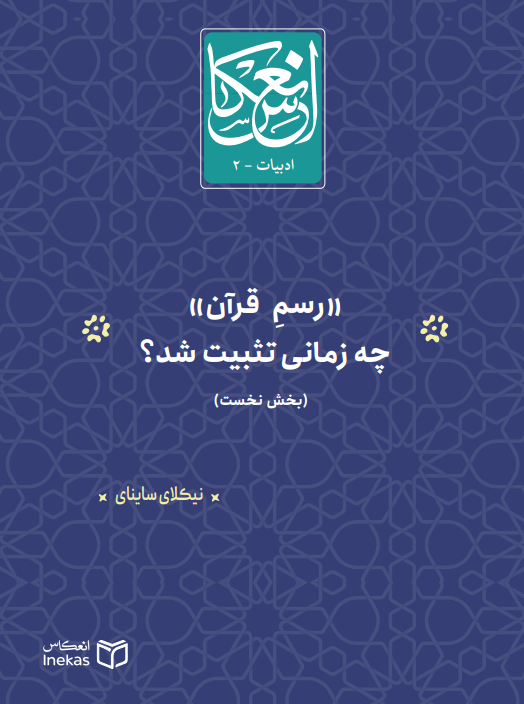Inekas translated Nicolai Sinai‘s article “When did the consonantal skeleton of the Quran reach closure?” (part 1 and part 2) into Persian. You can download the first part from here.
The following is an introduction that Nicolai Sinai graciously provided for the Persian readers.
Ten Years On: Preliminary Remarks on the Persian Translation of “When Did the Consonantal Skeleton of the Quran Reach Closure?”
Nicolai Sinai
When I learnt that a Persian translation of my 2014 article “When Did the Consonantal Skeleton of the Quran Reach Closure?” was being prepared for publication, I felt greatly honoured and pleased. There is still too little communication and discussion between students and scholars of the Qur’an based in the Islamic world, on the one hand, and those based in Europe and North America, on the other. Translations are obviously an excellent way of gradually changing this situation, and I am grateful to all those who have laboured to render my article into Persian.
The article republished here does of course not fully reflect the current state of the academic debate anymore. To be sure, my principal claims – namely, that the standard rasm of the Qur’an had come into existence by c. 650 CE and that it was promulgated as the standard text of scripture by the caliph ʿUthmān – continue to be shared by a majority of Qur’anic scholars writing in English, French, or German. But over the last decade there has been significant further work on early Qur’anic manuscripts and the Qur’an’s early written transmission, on Qur’anic reading traditions, and on the implications of the Qur’an’s canonical rasm for the linguistic features of Qur’anic Arabic. For example, Marijn van Putten has examined the way in which the phrase niʿmat allāh is spelled in fourteen early Qur’anic manuscripts and has found that their consistent use of either tāʾ or tāʾ marbūṭah in the same places of the text implies that all of these manuscripts are descended from a single written archetype (see van Putten, “Grace of God”). Generally speaking, even in light of more recent publications I would still stand by most of the arguments put forward in my 2014 article, such as its attempt to show that certain internal features of the Qur’an are not easily compatible with the hypothesis that the Qur’anic text was fixed as late as the reign of ʿAbd al-Malik. At the same time, I would continue to add, as I did in my 2014 article, that historical scholarship cannot rule out that certain revisions and additions could have been made to the Qur’anic text in the first decade or so after the death of the Prophet (on which see now, e.g., Sinai, Key Terms, 130–133, 155–158, 203–205). It should be noted that my formulation “cannot rule out” is meant to reflect that I am not confident that this is, conversely, capable of positive proof. As one might say, God knows best.
It is certainly fair to say that my article has not convinced everyone. As I discuss in more detail in a forthcoming essay that is in certain respects a sequel to the article at hand (Sinai, “Christian Elephant”), scholars like Stephen Shoemaker continue to maintain that the standard text of the Qur’an was likely codified and promulgated under ʿAbd al-Malik and that much of its content is not a verbatim reflection of the proclamations made by Muhammad in the early decades of the 7th century. Shoemaker’s recent monograph Creating the Qur’an is a comprehensive attempt to restate the case for an Umayyad dating of the Qur’an, in some cases in explicit conversation with the article here translated. Although this is not the place to go into details, I am on balance still convinced that Shoemaker’s model entails major difficulties and that it offers a less satisfying explanatory framework for the Qur’an’s genesis than the traditional scenario according to which the Qur’anic text was largely proclaimed in Mecca and Medina prior to the Arab conquest movement and was standardised by c. 650 CE. (For specific objections to Shoemaker and others broadly in agreement with him, see Sinai, “Christian Elephant” as well as Little, “In Defence”.)
It is, however, equally important to insist that, as a matter of principle, historical scholarship will only ever be approximative and that there are some aspects of the traditional model for the genesis of the Qur’an that produce at least minor explanatory anomalies. Given the residual uncertainty attaching to any historical reconstruction, it is therefore appropriate to keep an open mind about scholarship that proposes to subject generally accepted historical assumptions to critical scrutiny. Even if it will eventually turn out that the assumptions in question remain valid, it is likely that in the wake of the debate our historical insight will have progressed in some way. I would therefore reject the accusation that publications questioning aspects of the standard narrative of the Qur’an’s emergence are necessarily bound to be nothing more than polemically motivated attacks on deeply held Islamic beliefs.
Additional readings
Little, Joshua J. “In Defence of the ʿUthmānic Canonisation: A Response to Stephen Shoemaker.” Forthcoming.
Shoemaker, Stephen J. Creating the Qur’an: A Historical-Critical Study. Oakland: University of California Press, 2022.
Sinai, Nicolai. Key Terms of the Qur’an: A Critical Dictionary. Princeton: Princeton University Press, 2023.
Sinai, Nicolai. “The Christian Elephant in the Meccan Room: Dye, Tesei, and Shoemaker on the Date of the Qurʾān.” Forthcoming in the Journal of the International Qur’anic Studies Association.
van Putten, Marijn. “’The Grace of God’ as Evidence for a Written Uthmanic Archetype: The Importance of Shared Orthographic Idiosyncrasies.” Bulletin of SOAS 82, no. 2 (2019): 271–288.
